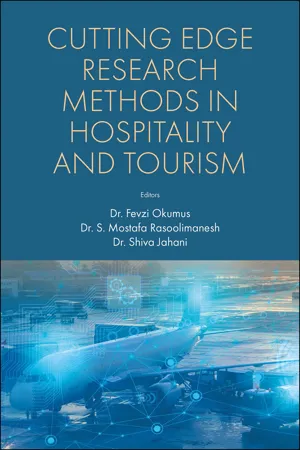
Cutting Edge Research Methods in Hospitality and Tourism
- 280 pages
- English
- ePUB (mobile friendly)
- Available on iOS & Android
Cutting Edge Research Methods in Hospitality and Tourism
About This Book
Cutting Edge Research Methods in Hospitality and Tourism sits at the forefront of fast-paced developments in the tourism and hospitality industry, highlighting the importance of applied and pure research to address the theoretical and practical problems and gaps. Approaching from different perspectives including economic, social, cultural, environmental, political, and technological, this edited collection reviews traditional research methods and re-assesses them to suit contemporary problems and research agendas.
Developing recent research strategies under the umbrella of quantitative and qualitative research methods – such as the use of structural equation modeling analysis, applied econometric research, network theory and social network analysis, using tracking mobility and planning exercises, fuzzy-set Qualitative Comparative Analysis, necessary condition analysis, and netnography approaches – can offer promising solutions.
A necessity for academics and practitioners in the tourism and hospitality sector, Cutting Edge Research Methods in Hospitality and Tourism expands existing knowledge, generating innovative research.
Frequently asked questions
Information
Table of contents
- Cover
- Title
- Chapter 1. Introduction
- Chapter 2. Which SEM to Use and What to Report? A Comparison of CB-SEM and PLS-SEM
- Chapter 3. Using PLS-SEM to Test for the Moderation Effects of Continuous Variables in Hospitality and Tourism Studies
- Chapter 4. Econometric Analysis in Hospitality and Tourism Management
- Chapter 5. Tourism Growth, Income Inequality and the Dependence Between Their Quantiles: Evidence from Quantile on Quantile Approach
- Chapter 6. Network Analysis in Tourism and Hospitality: A Comprehensive Review
- Chapter 7. “Why Not Study What Tourists Actually Do, Instead of Asking Them What They Think They Do?” A Call for More Experiments in Tourism and Hospitality Research
- Chapter 8. Guideline for Application of fuzzy-set Qualitative Comparative Analysis (fsQCA) in Tourism and Hospitality Studies
- Chapter 9. Application of Necessary Condition Analysis (NCA) in Hospitality and Tourism Research
- Chapter 10. Netnography and Its Potential for Studies in Tourism and Hospitality
- Chapter 11. Conclusions
- Index